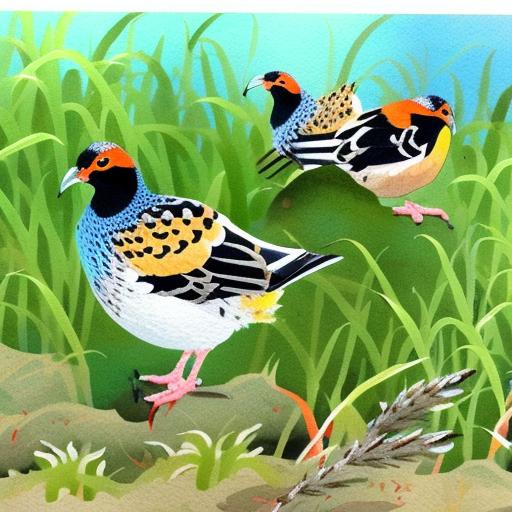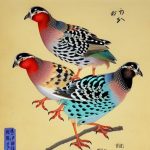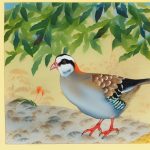Japanese quail, also known as Coturnix quail, are popular birds for breeding due to their small size, fast maturity, and high egg production. Understanding the basics of Japanese quail breeding is essential for successful breeding and raising healthy quail.
Japanese quail reach sexual maturity at around 6-8 weeks of age, making them an ideal choice for breeding purposes. They are also prolific layers, with each hen capable of laying up to 300 eggs per year. This makes them a valuable asset for those looking to produce eggs for consumption or for hatching.
When it comes to breeding, it’s important to understand the behavior and biology of Japanese quail. They are social birds that thrive in small groups, so it’s best to keep them in pairs or small flocks. Additionally, understanding their natural mating behaviors and egg-laying patterns can help breeders create the ideal environment for successful breeding.
Key Takeaways
- Japanese quail breeding requires careful selection of breeding stock and creating the ideal breeding environment.
- When selecting breeding stock, look for healthy, active birds with good body conformation and strong genetics.
- The ideal breeding environment for Japanese quail includes proper lighting, temperature, and ventilation to ensure optimal breeding conditions.
- Managing breeding pairs involves providing them with adequate space, nesting materials, and a balanced diet to support successful breeding.
- Monitoring egg production and incubation is crucial for ensuring a healthy and productive breeding program.
Selecting the Right Breeding Stock
Selecting the right breeding stock is crucial for successful Japanese quail breeding. When choosing breeding stock, it’s important to select birds that are healthy, free from genetic defects, and have good reproductive potential. Look for birds that are active, alert, and have a good body condition. Avoid birds that show signs of illness or deformities, as these traits can be passed on to the offspring.
It’s also important to consider the genetic diversity of the breeding stock. Inbreeding can lead to genetic abnormalities and reduced fertility, so it’s best to avoid mating closely related birds. Instead, aim to introduce new bloodlines into your breeding program to maintain genetic diversity and vigor.
When selecting breeding stock, pay attention to traits such as egg production, egg quality, and temperament. Choose birds that exhibit the desired traits you want to pass on to the next generation. By carefully selecting breeding stock, you can improve the overall quality of your quail flock and ensure a successful breeding program.
Creating the Ideal Breeding Environment
Creating the ideal breeding environment is essential for successful Japanese quail breeding. The breeding environment should provide the necessary conditions for quail to mate, lay eggs, and raise their young.
Start by providing a spacious and well-ventilated housing for your quail. The housing should be designed to accommodate breeding pairs or small groups of quail, with separate nesting areas for the hens to lay their eggs. The nesting areas should be filled with soft bedding material such as straw or wood shavings to provide a comfortable and secure environment for egg-laying.
Maintain a consistent lighting schedule to stimulate reproductive activity in your quail. Provide 14-16 hours of light per day to encourage mating behavior and egg production. It’s also important to provide a balanced diet that is high in protein and essential nutrients to support reproductive health and egg production.
In addition to providing the right physical environment, it’s important to create a stress-free and peaceful atmosphere for your quail. Minimize disturbances and handle the birds gently to reduce stress and encourage natural breeding behaviors. By creating the ideal breeding environment, you can maximize the reproductive potential of your quail and increase the likelihood of successful breeding.
Managing Breeding Pairs
Managing breeding pairs is an important aspect of Japanese quail breeding. When pairing quail for breeding, it’s important to consider factors such as age, genetics, and compatibility. Pair birds that are of similar age and reproductive maturity to ensure successful mating and egg production.
It’s also important to monitor the behavior of breeding pairs to ensure they are compatible and not exhibiting aggressive or territorial behavior. Provide enough space and resources for each pair to minimize competition and stress. If aggression occurs between pairs, consider separating them or providing visual barriers to reduce conflict.
Monitor the mating behavior of breeding pairs to ensure successful fertilization. If mating is not occurring, consider introducing new partners or adjusting the breeding environment to stimulate reproductive activity. Keep a close eye on the nesting areas to monitor egg-laying and ensure that the eggs are being properly incubated.
Regularly assess the health and condition of breeding pairs to ensure they are in optimal reproductive condition. Provide a balanced diet, clean water, and regular health checks to support their reproductive health. By effectively managing breeding pairs, you can increase the likelihood of successful mating, egg production, and hatching.
Monitoring Egg Production and Incubation
Monitoring egg production and incubation is crucial for successful Japanese quail breeding. Keep track of the number of eggs laid by each hen and monitor their quality to ensure optimal hatch rates. Collect eggs regularly to prevent them from being damaged or contaminated.
Once eggs are collected, store them in a cool and humid environment until they are ready for incubation. Use an incubator with controlled temperature and humidity settings to ensure optimal conditions for embryo development. Turn the eggs regularly to prevent the embryos from sticking to the shell membrane and promote even development.
Monitor the incubation process closely and be prepared to intervene if any issues arise. Keep an eye on the development of the embryos by candling the eggs regularly to check for signs of fertility and development. Remove any infertile or damaged eggs to prevent them from affecting the hatch rate.
As the hatch date approaches, prepare a brooder area with a heat source, bedding material, and water and food dishes for the newly hatched chicks. Monitor the hatching process closely and provide assistance if necessary to help chicks hatch successfully. By monitoring egg production and incubation closely, you can maximize hatch rates and ensure the health and vitality of the chicks.
Caring for Chicks and Young Quail

Caring for chicks and young quail is essential for their health and development. Provide a warm and secure brooder area with access to food, water, and heat to support their growth and well-being. Use a heat lamp or heat pad to maintain a consistent temperature of around 95-100°F during the first week of life, gradually decreasing it by 5°F each week until they are fully feathered.
Offer a high-protein starter feed specifically formulated for young quail to support their rapid growth and development. Provide clean water at all times and monitor their feeding behavior to ensure they are eating and drinking adequately. Keep the brooder area clean and dry to prevent disease and promote good hygiene.
Monitor the health of the chicks closely and be prepared to address any issues that may arise. Look out for signs of illness or weakness, such as lethargy, abnormal droppings, or respiratory symptoms. Provide prompt veterinary care if necessary to ensure the health and well-being of the chicks.
As the chicks grow, gradually introduce them to outdoor environments and larger living spaces to encourage natural behaviors and socialization. Monitor their behavior and interactions with other quail to ensure they are adapting well to their new environment. By providing attentive care and monitoring their development closely, you can raise healthy and thriving young quail.
Troubleshooting Common Breeding Issues
Despite careful planning and management, breeders may encounter common issues during Japanese quail breeding that require troubleshooting. One common issue is low egg production or poor hatch rates, which can be caused by factors such as stress, inadequate nutrition, or environmental conditions. Address these issues by providing a stress-free environment, a balanced diet, and optimal housing conditions for your quail.
Another common issue is infertility or poor fertility in eggs, which can be caused by factors such as age, genetics, or disease. To address this issue, carefully select breeding stock with good reproductive potential, provide regular health checks, and minimize stress factors that can affect fertility.
Aggression between breeding pairs or within flocks is another common issue that can disrupt breeding activities. Address this issue by providing enough space and resources for each pair or group of quail, introducing visual barriers to reduce conflict, or separating aggressive individuals if necessary.
Egg breakage during incubation or poor hatch rates can also be common issues during Japanese quail breeding. To address this issue, carefully handle eggs during collection and storage, maintain optimal incubation conditions, and monitor egg turning regularly to prevent developmental issues.
By troubleshooting common breeding issues promptly and effectively, breeders can overcome challenges and improve the overall success of their Japanese quail breeding program. Regular monitoring, attentive care, and proactive management are key factors in addressing common issues and ensuring a successful breeding program.
If you’re looking for Japanese quail breeding tips, you may also be interested in learning about the importance of providing a suitable coop for your poultry. A well-designed chicken coop can significantly impact the health and productivity of your birds. Check out this informative article on A-Frame Chicken Coop to discover practical tips and insights on creating a comfortable and functional living space for your quails and other poultry.
FAQs
What are some tips for breeding Japanese quail?
Some tips for breeding Japanese quail include providing a balanced diet, ensuring proper housing and nesting areas, monitoring for any signs of illness or disease, and maintaining a suitable breeding ratio of males to females.
What should be included in the diet of Japanese quail for breeding?
The diet of Japanese quail for breeding should include a balanced mix of high-quality commercial quail feed, fresh greens, and sources of calcium such as crushed oyster shells or eggshells to support egg production.
How should housing and nesting areas be set up for breeding Japanese quail?
Housing and nesting areas for breeding Japanese quail should provide enough space for the birds to move around comfortably, as well as nesting boxes or areas where the females can lay their eggs in a quiet and secluded environment.
What signs of illness or disease should be monitored in breeding Japanese quail?
Breeding Japanese quail should be monitored for signs of illness or disease such as decreased egg production, changes in behavior, abnormal droppings, respiratory issues, or any visible signs of injury or distress.
What is the ideal breeding ratio of males to females for Japanese quail?
The ideal breeding ratio of males to females for Japanese quail is generally recommended to be around 1 male to 3-4 females to minimize aggression and ensure successful breeding.
Meet Walter, the feathered-friend fanatic of Florida! Nestled in the sunshine state, Walter struts through life with his feathered companions, clucking his way to happiness. With a coop that’s fancier than a five-star hotel, he’s the Don Juan of the chicken world. When he’s not teaching his hens to do the cha-cha, you’ll find him in a heated debate with his prized rooster, Sir Clucks-a-Lot. Walter’s poultry passion is no yolk; he’s the sunny-side-up guy you never knew you needed in your flock of friends!







